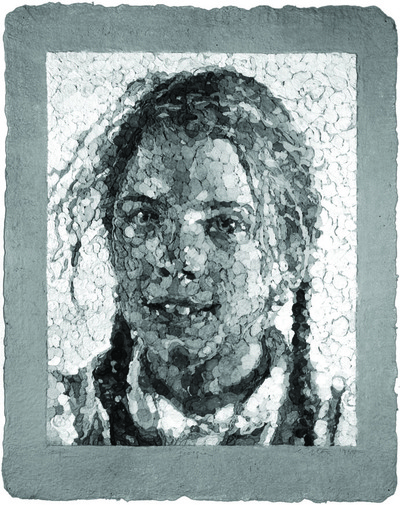CLOSER: THE GRAPHIC ART OF CHUCK CLOSE
Most portraits are shams. They multiply identities without exposing them. Chuck Close achieves something more revelatory by being interested only in faces, not histories.
His indifference to anything but surface leaves his subjects more unguarded. They
confess by accident.
There is something of the police sketch artist here. In John, a 1971 series of dye transfer prints in color separations of cyan, yellow and magenta, the self becomes visible as an aggregate gradually constructed from the eye’s spectrum testimony. This is visual evidence in the hands of an analyst, straining the face through the sieve of his penciled grid.

Chuck Close, Georgia, 1984, handmade paper, 56 x 44″. Private Collection, New York. © Chuck Close, courtesy of Pace Gallery. Photograph courtesy of Pace Prints.
The artist’s fingerprint as a drawing tool adds another forensic element, with Close fashioning images of other selves out of the pattern of his own identity in Phil, 1981; Marta, 1986; and Leslie, 1986. It is as if an illiterate’s signature was the clearest way for acknowledging what is his literal handiwork.
Printmaking for Close is not an end but a means. It allows him to reinvent other media. The mosaic saints of Ravenna are quoted, though here in an entirely secular hagiography, with its modern traditions of self-canonization. Mysteriously without ego, Close manages to be characteristically disengaged from his self-portraits, yet, knowing his own tricks, he gives little away. Even in the stunned images of 1988 and 1997, the look of surprise appears to be purely contrived for effect, rather than being the record of some actual moment of shocked disbelief.
Close’s reconsideration of photography as a digital matrix (the variants of Phil I, II, III) demands a process of seeing not unlike that of a Caravaggio painting. The resolution of details out of patterns of light only emerges when the viewer dances it into focus, moving closer, then further, from the image.
In Georgia, 1984, sculptural surfaces make the topography of the face’s planes into an actual landscape, like the drought-cracked surface of an abandoned farm. Here also is the perfect paradox of a child’s face with its prophecy of dying. Lucas/Book, 1991, is a comic strip of theatrical madness, its artist subject reveling in his mask. Finally, there is the infant Emma, 2002, as a pulp fiction giant, fierce and immortal.
